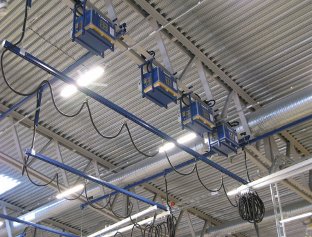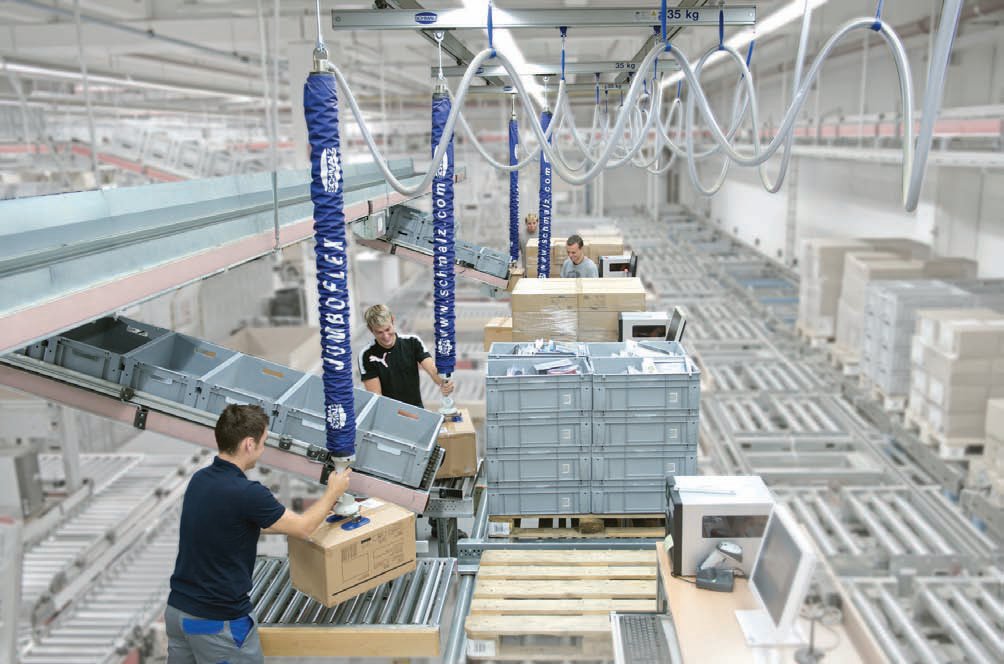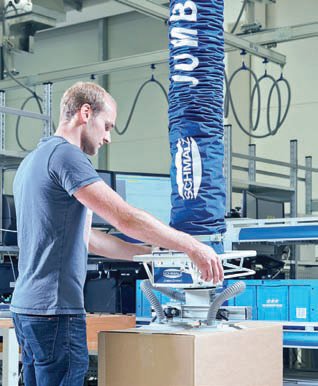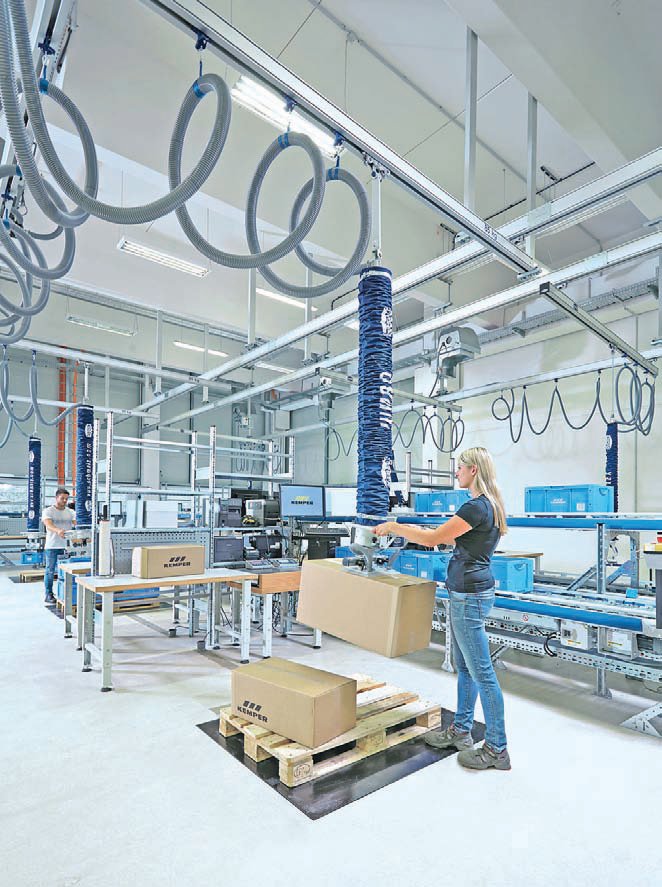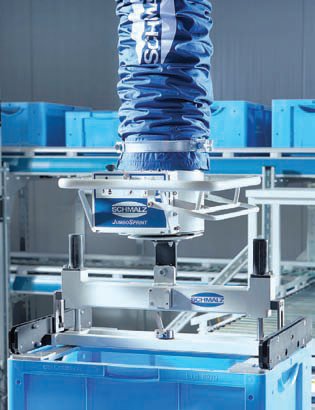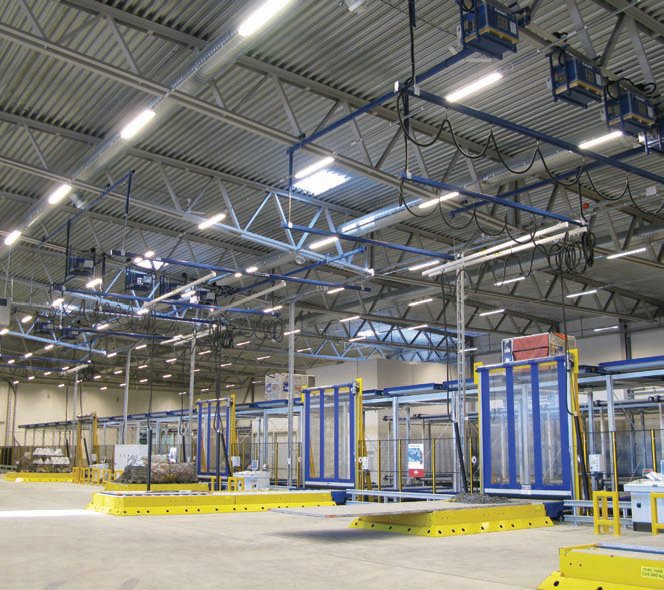Signed, sealed, delivered
29 June 2017As global trends in product distribution change, thanks to the growth in online shopping, lifting equipment must support this sector and ergonomic design is vital. Bernadette Ballantyne reports.
The growth in online shopping and trends in product distribution mean that lifting equipment is needed more than ever to support the safe and efficient manipulation and movement of goods. Ever-expanding warehouses are using automated racking and storage systems to efficiently host their products. Forklifts and scissor lifts are moving the boxes and pallets. Hoists, cranes and vacuum lifting devices are used to receive, pack and ship out the goods. The efficient, speedy and safe operation of the process is all-important if firms are to stay competitive, and this means using the best equipment to ensure firms achieve maximum productivity.
To this end, a wide range of lifting solutions are currently employed in the logistics sector. For example, Italy’s Dalmec supplies a range of industrial manipulators to factories, warehouses, workshops, distribution centres and industrial facilities all over the world. The bespoke pneumatic industrial manipulators can be fitted with a range of gripping devices to allow safe handling of goods in the warehouse and other environments. This combination can be used to handle loads of between 5kg–900kg, up to heights of around 2m. Commonly used for palletising and depalletising, the manipulators are custom-built to suit the environment of the user. For example, the pinch jaw gripping system combined with the manipulator model Partner Equo can lift layers of boxes, making it suitable for use during start- and end-of-line operations. The Equo has a maximum lifting capacity of 550kg and a working radius of 4,000mm, with a vertical lift up to 2.45m.
VACUUM LIFTING
Suction devices too are common in warehouses and distribution as owners and logistics firms acknowledge the need for ergonomic lifting solutions that reduce the potential for musculoskeletal impact on workers. The Dalmec manipulator Speedyfil is often used to move smaller loads in large volumes. Generally, the device is mounted on an overhead trolley double-track system allowing it to cover a wide area, although it can be column-mounted too. To operate, a pneumatic cylinder is fed with compressed air, combined with a transmission level system, providing balance to the load weight applied. The cylinder force is controlled through two pneumatic circuits purposely arranged; the first one keeps the weight system balanced, the second keeps the weight load steady. The operator can change the load level by adjusting the balancing system which, in line with good ergonomic design, has been positioned on the operating handle of the tool. Its maximum capacity is 80kg and it has a 2m maximum working radius, with a vertical lift of up to 1.65m.
German manufacturer Schmalz also specialises in vacuum lifting technology, which it supplies alongside its aluminium crane systems, designed in tandem with the vacuum lifters to ensure that the final solution is appropriately coordinated for the job in hand. The company divides its portfolio of vacuum lifters into the Jumbo and VacuMaster ranges, with the Jumbo being most common in the distribution and logistics environments.
The machines are used at both the receiving and shipping ends of the distribution centre as well as for parcel distribution, packing of goods into boxes and baggage handling. Three models are available with the smallest, the JumboFlex used for one-hand operation of workpieces weighing up to 50kg and capable of high cycle rates. The next model in the range, the JumboErgo, can lift a wide range of loads of up to 300kg and the JumboSprint is designed for smaller but equally heavy items.
From an ergonomic perspective, the machines are designed for one-handed control with a comfortable handle enabling long use periods and the one-finger control designed to make lifting, lowering and releasing intuitive. The larger JumboFlex comes with a quick-change system for replacing the vacuum grippers. A range of grippers are available depending on the loads to be lifted. Simple single or double suction cups can be replaced by quadruple or multiple grippers, hooks and a box gripper.
Supporting the vacuum lifters are the Schmalz aluminium crane systems which can be configured as single girder, double girder or monorail types with a capacity of up to 1,200kg. Jib cranes are also offered with a 1,000kg maximum capacity. The aluminium crane rail supplied can run from 2m and 6m. The column is made of steel and can support the crane rail at up to 4m height, making the system a maximum of 5m tall. Alternatively, the crane rail can be wall-mounted. The firm also makes chain hoists for loads of up to 2,000kg.
Logistics solution
A recent customer of Schmalz, ABB Schaffhausen invested in the vacuum lifting technology to improve material flow in its logistics centre. The Schaffhausen location, with around 320 employees, originated from the family company Carl Maier & Cie, founded in 1909 and integrated into the ABB group in 1992. In Schaffhausen, ABB bundles the development, production, logistics and sale of low-voltage, personal protection and building protection devices as well as switches and sockets. The most famous product is the company’s residual current circuit breaker.
ABB set up two logistics centres at the Schaffhausen location and a major challenge was to create sufficient storage space on the existing site. The project team finally decided to build an automated small parts warehouse (AKL) but needed to find a way to ensure that thousands of products could be efficiently and quickly installed and outsourced. The goals were ambitious stored in a process-safe and sensitive manner and positioned just as quickly as exactly. ABB was also looking for an ergonomic solution.
After a lengthy selection process Schmalz recommended the use of the vacuum hose lifter JumboFlex 50. Two of these were selected for loading and unloading, fitted with crate grippers. In addition, the vacuum specialist supplied wall swivel cranes made of aluminium. They are very light, run quietly and enlarge the area of application of the hose lifter significantly. Its light weight ensures a fast operation and requires little force during operation, says the manufacturer, and thanks to high-quality and wear-resistant components made of aluminium and plastic, the system requires very little servicing.
The gripping mechanism of the hose lifters, according to Schmalz, cannot damage the crate and contents. Together, the project partners have developed a mechanical crate carrier for gentle transport. It moves into the frame of the crate at only four points and is locked and unlocked with a ‘ball-point mechanism’. The one-hand operation has a very positive effect—the crates can be picked up very gently, as well as directed and exactly aligned. “My team now works very well with the lifting aids,” says Herbert Fichthaler, production engineer at ABB Schaffhausen.
In two-shift operation, approximately 1,000 crates are moved at ABB every five days a week. In the beginning, the staff had to get used to the new way of handling. But the advantages of the Schmalz solution were quickly shown. "Today, the team members teach each other, and after 15 minutes start-up help they work independently. Without the lifting aids we would not be more efficient in our logistics centre," says Fichthaler.
AviAtion support
Other logistics facilities made more efficient with lifting equipment include the airport cargo handling facilities of Stockholm Arlanda and Gothenburg Landvetter airports, owned by SAS. Here, 26 units of Swedish light lifting specialist TAWI’s VacuCobra vacuum lifters were supplied to the cargo loading stations. Each loading station contains two vacuum lifters suspended from a separate lightweight aluminium crane bridge, itself supported by a gantry system covering a 10m by 15m work area. The firm says that its lifters are designed for high-speed box handling with a handle designed for both left- and right-hand operations. Like other lifters the VacuCobra has a quick-release function to increase handling speed and the suction cup can lift loads of variable size and shape.
Also in Sweden, TAWI customer the Swedish Alcohol Retailing Monopoly (Systembolaget) has been using the firm’s lifting equipment since 1997 as part of a drive to create an ergonomic and safe working environment for staff. In partnership with TAWI the firm’s ergonomic experts supported the development of special versions of the VacuCobra and its sister product the VacuEasyLift. The need to handle heavy and fragile wine boxes led to the development of a special suction foot. The company also uses the Protema electric lifting trolley for lifting pallets and boxes. The battery-operated trolley comes in eight different models and can lift loads of 40kg (PRO40) to 200kg (PRO200).
Finland’s Konecranes sells products in to the warehousing and manufacturing sector too. Its jib cranes supplied with the CLX or SLX electric chain hoists are used for loading unloading and moving goods in warehouses and production facilities. Particularly useful for industries and logistics requiring the movement of larger or heavier items the hoists have a 5,000kg capacity. They are also fitted with a brake and slipping clutch to prevent loads from dropping or microslipping.
The five models have a range of lifting speeds from 0.7m–20m per minute. Its jib cranes have a 2,000kg capacity and a 270° slewing range for the free-standing cranes or 180° for wall-mounted versions. An adjustable console bearing at the top plate allows adjustment of the horizontal beam.
Ergonomic Emphasis
Common to these manufacturers is the drive towards better ergonomic design, defined by the International Ergonomics Association as: “The scientific discipline concerned with the understanding of interactions among humans and other elements of a system, and the profession that applies theory, principles, data and methods to design in order to optimise human well-being and overall system performance. Practitioners of ergonomics and ergonomists contribute to the design and evaluation of tasks, jobs, products, environments and systems in order to make them compatible with the needs, abilities and limitations of people.”
In simple terms: “It is the design of the work and the workplace to suit the needs of the work and the worker,” explains John Ridd, director and principal ergonomics at JRP Ergonomics who specialises in musculoskeletal disorders caused in the workplace. He says that in his experience, manufacturers are working to make their equipment more operator-friendly but in many cases the needs of the job site take priority over worker comfort and safety. Added to this many facility owners operate using old equipment which has not been ergonomically designed.
For safe operations, it is necessary to break loads down into more manageable weights and dimensions, however using lifting equipment reduces some of the need for this by enabling operators to comfortably manage larger sizes and volumes of packages. This eliminates some of the key health concerns around lower back issues associated with repetitive manual lifting of light weights. “The thing that you have to watch out for is cardiovascular—people getting fatigued as they lift lighter loads more frequently,” explains Ridd.
As automation increases productivity and efficiency, human impact will still be required, says Ridd. “There is a lot of concern that robotics will take away employment, but because of the increased productivity and so forth you end up with a good balance because there is more work either end.”
Efficiency gains
Germany’s Kemper, which recently built a new logistics centre at its production facility, has put ergonomic design at the heart of its solution in a bid to ensure that its workplace remains safe and efficient for all, particularly elderly workers. Its new logistics centre can house 36,000 storage spaces for the 600 x 400 x 270mm cartons containing its products, which range from plumbing fittings to rolled copper strips and gunmetal products.
“We have faced the demographic change and created suitable conditions for older workers,” says Frank Leistritz, head of the factory at Kemper. The company had taken a new approach with the project. “For us, the topic of ergonomics is extremely important. That is why we have designed innovative workstations for logistics and assembly together with the specialists SSI Schäfer and Asstec,” he says.
Storage specialists SSI Schäfer recommended Schmalz vacuum lifters for the 50kg containers. In turn the manufacturer proposed that the JumboSprint 85 vacuum lift was used along with aluminium running cranes.
Workpieces are raised and lowered using a simple handle and two gripper systems were supplied depending on the load to be lifted. A crate carrier is used which has special claws and an automatic latching system for lifting the mini carriers. For the larger cartons, a double gripper is used. In total Schmalz supplied a total of 14 of the JumboSprint 85 vacuum hose lifters and four JumboFlex 35 units, several aluminium suspension cranes, and a column swing crane. The suction devices are used at important points in the material flow process from goods receipt to assembly, quality assurance and dispatch. “The first experiences are very positive. We made the right decision,” says Leistritz who notes that the employees adapted well to using the new equipment. The assembly and logistics specialists are also very satisfied with the lightweight aluminium cranes. “With them, we can easily reach our labour platforms and manage longer distances,” says Leistritz. “The solutions make the workstations in our new hall much more ergonomic and efficient.”
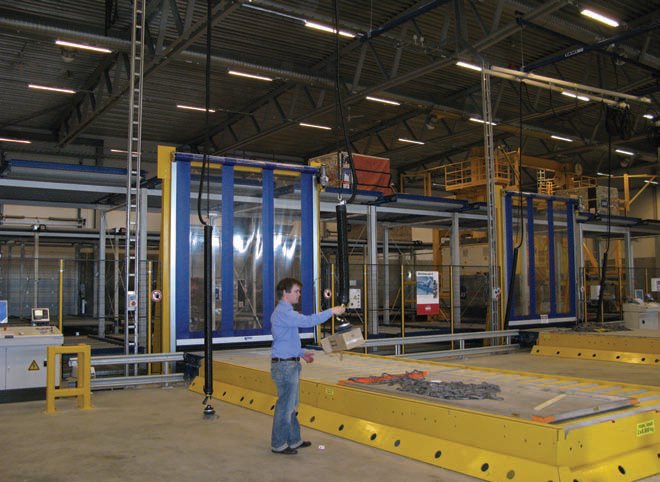 Airports in Stockholm and Gothenburg purchased 26 of the VacuCobra lifters to support cargo handling. Vorankundigung: The JumboFlex from Schmalz is used to achieve high turnover rates
Airports in Stockholm and Gothenburg purchased 26 of the VacuCobra lifters to support cargo handling. Vorankundigung: The JumboFlex from Schmalz is used to achieve high turnover rates
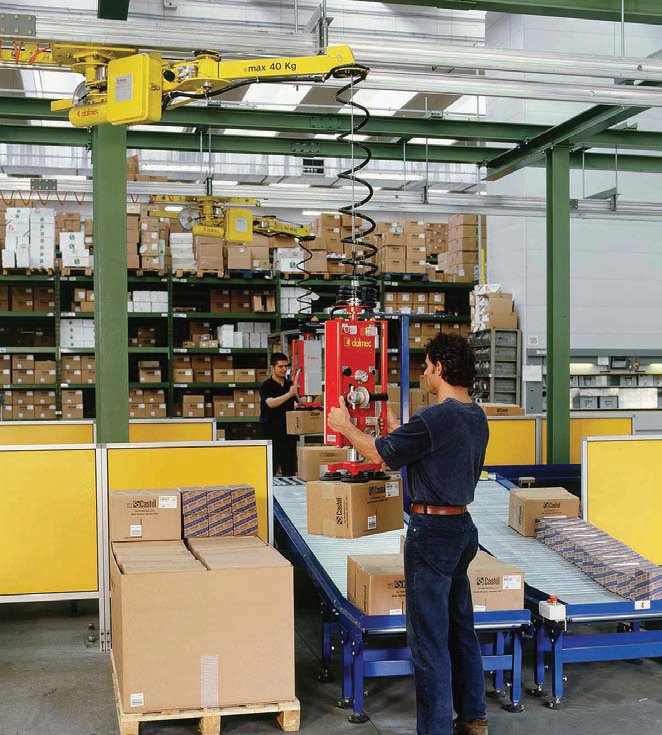 The Speedyfil industrial manipulator is overhead trolley mounted on an aluminium running system and is equipped with a Venturi vacuum suction system for the gripping of boxes.
The Speedyfil industrial manipulator is overhead trolley mounted on an aluminium running system and is equipped with a Venturi vacuum suction system for the gripping of boxes.
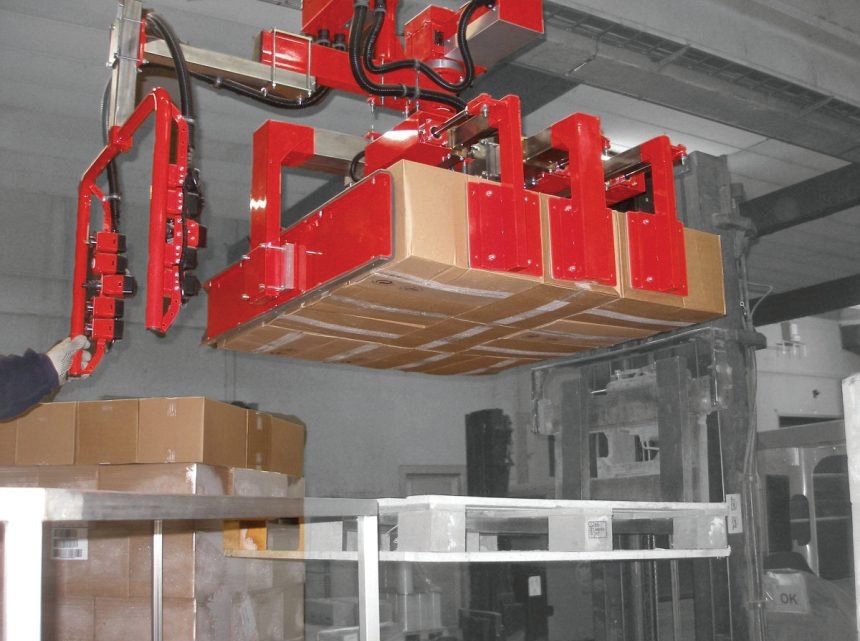 Dalmec pinch jaws gripping system for cardboard boxes stacked in layers. The tooling applied to the Partner Equo industrial manipulator handles complete layers, composed of 12 boxes up to 2m height.
Dalmec pinch jaws gripping system for cardboard boxes stacked in layers. The tooling applied to the Partner Equo industrial manipulator handles complete layers, composed of 12 boxes up to 2m height.
